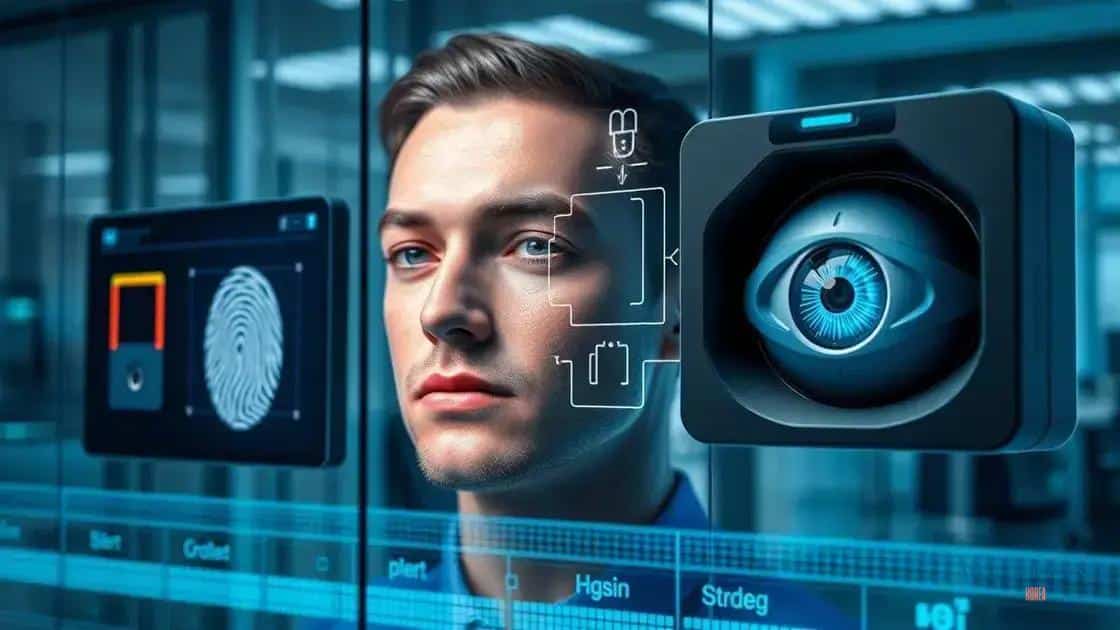The rise of biometric security systems for personal devices

The rise of biometric security systems for personal devices enhances security and convenience by using unique biological traits for user authentication, while also facing challenges like privacy concerns and implementation costs.
The rise of biometric security systems for personal devices is transforming how we protect our personal information. Have you ever wondered how these technologies work and what makes them a game-changer? In this article, we’ll delve into the fascinating world of biometric security.
Understanding biometric security systems
Understanding biometric security systems is essential in today’s digital landscape. These systems utilize unique biological traits to verify identities. This technology is growing rapidly, offering increased security for personal devices.
What Are Biometric Security Systems?
These systems analyze physical or behavioral characteristics, such as fingerprints or voice patterns. They replace traditional passwords with more reliable authentication methods.
Key Features of Biometric Systems
Biometric security systems have several notable features:
- Accuracy: They provide a high level of precision in user identification.
- Convenience: Users can access their devices easily without remembering complex passwords.
- Fraud Prevention: They reduce identity theft risks by making unauthorized access more difficult.
Many devices now incorporate biometric technology, making it a mainstream solution for personal security. As users become more aware of the importance of security, the demand for these systems continues to grow. Adoption of biometric technology can also lead to improved user experiences, making everyday tasks easier.
Moreover, biometric systems are not just limited to phones; they also play significant roles in laptops, security doors, and even ATMs. This ubiquity reflects how integrated biometric systems have become in our lives. As technology advances, these systems will likely become more sophisticated and widely accepted.
Why Choose Biometric Security?
Choosing biometric security can enhance safety and usability. It eliminates the need for memorizing numerous passwords, allowing seamless access to devices.
With the increasing reliance on digital devices, the effectiveness of biometric authentication offers reassurance. It provides users with confidence in the protection of their personal data. As our world becomes more interconnected, understanding these systems is crucial for ensuring digital security.
Types of biometric technologies available

When exploring types of biometric technologies available, it’s essential to understand their various applications and advantages. Biometric systems can be categorized based on the traits they utilize for identification. This technology is becoming increasingly popular across many sectors, enhancing security and user convenience.
Fingerprint Recognition
Fingerprint recognition is one of the most widely used biometric technologies. It captures unique patterns of ridges and valleys on a person’s fingertip. This method is commonly found in smartphones and security systems.
Facial Recognition
Facial recognition technology analyzes facial features from images. It can identify or verify a person’s identity by comparing facial traits to a database. This system is now prevalent in airports and security checkpoints.
- Examples of use: Access control in buildings and identification at events.
- Advantages: Quick and contactless identification.
- Limitations: Can be affected by lighting conditions and angles.
Another popular technology is iris recognition. This method uses the unique patterns of the iris, offering a high level of accuracy. Iris scanners can be found in high-security environments, such as military and government buildings.
Voice Recognition
Voice recognition technology identifies individuals based on their voice patterns. It works by analyzing unique vocal traits and is increasingly used in virtual assistants and secure communication systems.
Lastly, behavioral biometrics focuses on patterns of behavior, such as typing rhythm or mouse movements. This innovative approach can help detect unauthorized access by monitoring user behavior over time, offering a layer of security that is difficult to replicate.
Each type of biometric technology serves specific needs and has its distinct advantages and challenges. As advancements continue, integrating these technologies will likely become seamless in daily life, enhancing convenience and security for users everywhere.
Advantages of biometric systems for personal devices
The advantages of biometric systems for personal devices are numerous and impactful. By utilizing unique biological traits, these systems enhance security while providing convenience to users. Users no longer need to remember passwords or PINs, which can be easily forgotten or stolen.
Enhanced Security
One significant advantage is the improved level of security provided by biometrics. Unlike traditional passwords, biometric features, such as fingerprints or facial recognition, are nearly impossible to replicate. This makes unauthorized access much more challenging.
Convenience and Speed
Biometric authentication is not only secure but also quick. Users can unlock their devices and access applications within seconds. This speed enhances the overall user experience, making technology more accessible.
- Easy to use: Just a touch or glance is enough.
- No need to memorize: Forgetting passwords becomes a thing of the past.
- Integrated with devices: Many smartphones and computers now come with built-in biometric capabilities.
Additionally, biometric systems can offer personalization. They can adjust settings based on the user’s identity, providing a tailored experience. For example, different users on a shared device may have unique preferences that biometrics can recognize automatically.
Another major benefit is fraud detection. Biometric systems can track user behavior and identify discrepancies. This can alert users and prevent unauthorized attempts to access sensitive information. As technology evolves, these systems become smarter and more effective at protecting user data.
With the growing emphasis on security, the adoption of biometric systems will likely continue to rise. Understanding the advantages they offer can help users make informed decisions about securing their personal devices in an increasingly digital world.
Challenges of implementing biometric security

While there are numerous benefits to biometric security, several challenges of implementing biometric security systems must be acknowledged. Understanding these challenges can help users and organizations make better decisions when adopting these technologies.
Privacy Concerns
One major concern is privacy. Collecting biometric data raises issues about how this information is stored and used. There are fears that personal biometric data could be misused or fall into the wrong hands.
Costs and Infrastructure
Implementing biometric systems can also be expensive. The cost of hardware, software, and ongoing maintenance can add up. Organizations need to invest in the right infrastructure to support these systems effectively.
- Training: Employees may require training to use these systems effectively.
- Updates: Regular software updates are essential for security.
- Integration: Ensuring the biometric system works with existing technologies can be complex.
Another important challenge is the potential for errors. Biometric systems are not infallible; they can misidentify individuals due to factors such as environmental conditions or user errors. For example, moisture on a finger can affect fingerprint scanners, leading to failed attempts to access devices.
Additionally, accessibility can be an issue. Not all users may be able to provide their biometric data. For instance, individuals with certain disabilities might find it challenging to use specific biometric systems. This raises questions about inclusivity in security technologies.
As organizations work to implement biometric security, they must carefully consider these challenges. Addressing privacy, cost, and accessibility issues is crucial for successful adoption. By understanding these factors, users can ensure that biometric technologies serve their intended purpose without compromising security or usability.
Future trends in biometric security technology
The future trends in biometric security technology are exciting and full of potential. As technology advances, we can expect innovative developments that enhance security and usability in personal devices.
Increased Adoption Across Industries
More industries are starting to adopt biometric security. Companies in finance, healthcare, and even retail are integrating biometric systems. This integration helps streamline processes and secure sensitive information more effectively.
Integration with Artificial Intelligence
Another trend is the integration of biometric systems with artificial intelligence (AI). AI can improve the accuracy of biometric recognition systems. For example, AI algorithms can learn to distinguish between legitimate users and potential threats more effectively.
- Personalized Security: AI can tailor security measures based on user behavior.
- Adaptive Systems: Over time, systems can learn and improve their recognition capabilities.
- Enhanced Fraud Detection: AI can analyze patterns to detect unusual activities.
Moreover, advancements in wearable technology are shaping the future of biometrics. Devices like smartwatches and fitness trackers are beginning to include biometric features. These devices can monitor users’ health while also offering security, making biometric data collection easier and more efficient.
Another significant trend is the move toward multimodal biometrics. This method uses multiple biometric traits, such as combining fingerprint and facial recognition for authentication. This increases security by requiring more than one form of identification. By fusing different biometrics, users benefit from higher accuracy and improved security measures.
Privacy-First Approaches
As privacy concerns grow, future biometric systems will likely prioritize user consent and data protection. Companies will need to implement more transparent data handling practices. This could include giving users more control over their biometric data and how it is stored.
Overall, the future of biometric security technology promises to be innovative and user-focused. As advancements continue, we can expect more secure and convenient methods for protecting our personal devices.
FAQ – Frequently Asked Questions about Biometric Security Systems
What are biometric security systems?
Biometric security systems use unique biological traits, like fingerprints or facial recognition, to verify identities and enhance security.
What are the main advantages of using biometric systems?
Biometric systems offer improved security, convenience for users, and eliminate the need for remembering passwords.
What challenges do biometric systems face?
Challenges include privacy concerns, implementation costs, and potential errors in identification due to environmental factors.
How is the future of biometric security technology shaping up?
The future includes increased AI integration, a focus on user privacy, and the adoption of more personalized and seamless security solutions.






